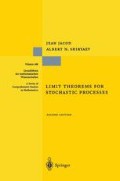Abstract
The question of absolute continuity or singularity (ACS) of two probability measures has been investigated a long time ago, both for its theoretical interest and for its applications to mathematical statistics. S. Kakutani in 1948 [125] was the first to solve the ACS problem in the case of two measures P and P’ having a (possibly infinite) product form: P = µ1⊗µ ’1 ⊗µ ’2 ⊗... and P’=µ1⊗µ2⊗, when μ n ~ μ ’n (μ n and μ ’n are equivalent) for all n; he proved a remarquable result, known as the “Kakutani alternative”, which says that either (math) (P and P′ are mutually singular). Ten years later, Hajek [80] and Feldman [53] proved a similar alternative for Gaussian measures, and several authors gave effective criteria in terms of the covariance functions or spectral quantities, for the laws of two Gaussian processes.
Access this chapter
Tax calculation will be finalised at checkout
Purchases are for personal use only
Preview
Unable to display preview. Download preview PDF.
Bibliographical Comments
Kakutani [124] was the first to exploit the “Kakutani-Hellinger” distance for absolute continuity-singularity problems, but the corresponding integrals were introduced in analysis by E. Hellinger; their relations with the variation metric are well known (see Chapter V). In connection with stochastic processes they have been used for example by Liese [150, 151, 152] and Newman [190]. Hellinger processes and their explicit form 1.34 were introduced by Liptser and Shiryaev [162] for studying contiguity, while the presentation of these as compensators of suitable processes appears in Mémin and Shiryaev [179] and Jacod [102]. The material in § Id is new and could presumably lead to many other applications: for instance taking ψ(x) = Log x would give a “Kullback process” associated with Kullback information as Hellinger processes are with Hellinger integrals.
The problem of finding necessary and sufficient conditions for absolute continuity of measures associated with processes has a long story, starting with Kakutani. The problem was firstly solved in the “independent case”, for Gaussian processes and for diffusion processes: Hajek [80], Feldman [53], Ibragimov and Rozanov [90] (for more historical details, see the bibliography of Liptser and Shiryaev [157]). The development of stochastic calculus allowed to solve the problem in general, assuming local absolute continuity (see Jacod and Mémin [106] for the quasi-left continuous case, Kabanov, Liptser and Shiryaev [120] for the general case, and also Engelbert and Shiryaev [50] in the discrete-time setting). The general case (without local absolute continuity) comes from Jacod [102]. Another generalization, not involving semimartingales, can be found in Fernique [55]. The criteria developped in the present chapter lead to “deterministic” criteria for PII’s which naturally generalize Kakutani’s Theorem 2.38, and to conditions on the coefficients for diffusion processes. The proofs given here are new and seem much simpler than the previous ones. For an elementary exposition of the discrete-time case, one can also consult the text-book [222] of Shiryaev.
Now about Sections 3 and 4: the first explicit computations of Hellinger processes in terms of characteristics of semimartingales are in Liptser and Shiryaev [165] and Mémin and Shiryaev [179] for PII’s (Theorem 4.32). The presentation and the general results of Section 3 are new. Theorem 4.6 appeared in Kabanov, Liptser and Shiryaev [118], and 4.16 in Kabanov, Liptser and Shiryaev [119]; apart from a different presentation, Theorem 4.23 comes from Liptser and Shiryaev [157]. § 4c is essentially borrowed from Mémin and Shiryaev [179], but the case of PII’s without fixed time of discontinuity already is in Skorokhod [224]; see also Newman [190].
Author information
Authors and Affiliations
Rights and permissions
Copyright information
© 2003 Springer-Verlag Berlin Heidelberg
About this chapter
Cite this chapter
Jacod, J., Shiryaev, A.N. (2003). Hellinger Processes, Absolute Continuity and Singularity of Measures. In: Limit Theorems for Stochastic Processes. Grundlehren der mathematischen Wissenschaften, vol 288. Springer, Berlin, Heidelberg. https://doi.org/10.1007/978-3-662-05265-5_4
Download citation
DOI: https://doi.org/10.1007/978-3-662-05265-5_4
Publisher Name: Springer, Berlin, Heidelberg
Print ISBN: 978-3-642-07876-7
Online ISBN: 978-3-662-05265-5
eBook Packages: Springer Book Archive

